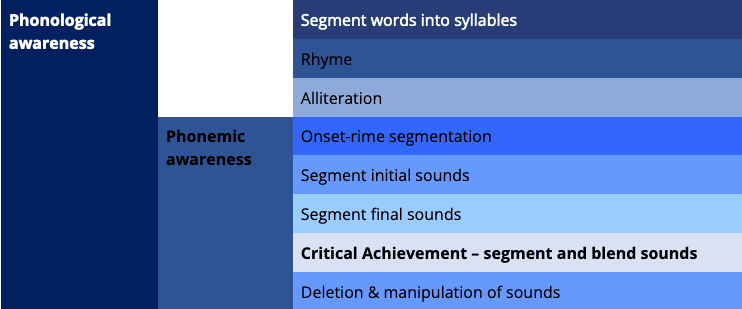Phonemic Awareness
Home » Phonemic Awareness
Phonological awareness and phonemic awareness are aural and oral skills that allow children to understand that speech is made up of words, and that words are made up of distinct sounds and sound patterns.
Phonological and phonemic awareness are highly predictive of early reading acquisition. Phonological awareness involves the identification and manipulation of parts of spoken language, including words, syllables, onsets and rimes, and the individual speech sounds in words (phonemes). Phonemic awareness is a subset of phonological awareness that involves the specific skill of identifying and manipulating individual speech sounds within words (phonemes).
These terms should not be confused with phonics, which is knowledge of how letters or groups of letters (graphemes) represent the sounds in speech. Strong phonemic awareness gives students an advantage in learning phonics, because it makes it easier for students to perceive phonemes and map them to graphemes for reading and spelling.
Phonemes are not always easy to distinguish because we don’t articulate them separately – they are buried in a constant stream of speech, or co-articulated (run together). Some phonemes are easily confused so learners should not be left to identify speech sounds in words unassisted. We need to explicitly teach phonemic awareness if children are to benefit from phonics instruction.
Components of phonological awareness

Adapted from Schuele and Murphy (2014) intensive phonological awareness program. Baltimore : Brookes Publishing
Initially, students are aware of the larger phonological units in spoken language, such as rhyme, alliteration and onset-rime segmentation. With exposure to spoken and written language as well as explicit teaching, students eventually develop an awareness of individual phonemes in words (phonemic awareness), allowing them to segment and blend sounds for spelling and reading.
References
Brady, S. (2020).
A 2020 perspective on research findings on alphabetics (phoneme awareness and phonics): implications for instruction.
The Reading League Journal
Moats, L. (2010).
Speech to print: Language essentials for teachers (3rd ed).
Brookes
Ehri, L. (2022).
What teachers need to know and do to teach letter-sounds, phonemic awareness, word reading, and phonics.
The Reading Teacher
Hempenstall, K. (2014).
Phonemic awareness: Yea or nay?
National Institute for Direct Instruction
